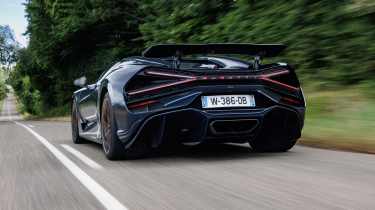New Bugatti Mistral review: a truly extraordinary drop-top
There is no experience quite like the one offered by Bugatti’s iconic W16 models, and none is more extraordinary than the incredible Mistral

Verdict
Comparing a Bugatti to a ‘normal’ car is probably like comparing Concorde and a paper aeroplane. The Mistral – on behalf of all W16-era models – represents a place and time in humanity’s engineering journey that broke boundaries and pushed the limits of what a road car could be. Yet what’s most incredible is how easy the Mistral is to use, and how beautifully polished its driving experience is.
Few modern brands command as much reverence as Bugatti. This iconic manufacturer of ultra-luxury cars has always seemed to operate in a vacuum, building the most exquisite and finely formed cars, irrespective of cost. This isn’t just in terms of the quality of leather used on the seats or its carbon-fibre body work, but the otherworldly engineering that goes into every single nut and bolt. It’s always a privilege to drive a Bugatti, but to drive the Mistral – which is the last, and one of the most expensive, of this generation – well, that’s bucket list stuff.
But what is the Mistral? Named after a strong wind in southern France, its limited-run of 99 units is a celebration of the Chiron era, fitted with a completely bespoke open-top body and a powertrain derived from the wild, record-breaking Chiron Super Sport 300+. In fact, to call it a powertrain is probably something of a disservice, because it’s arguably better likened to the propulsion units of steampunk locomotives – something that isn’t without precedent, given that Bugatti’s pre-war straight-eight did power high-speed trains during the second world war.
Used - available now

2022 Toyota
C-HR
31,659 milesAutomaticPetrol1.8L
Cash £20,218
2022 Toyota
Supra
13,849 milesAutomaticPetrol3.0L
Cash £43,599
2024 BMW
M135i
33,109 milesAutomaticPetrol2.0L
Cash £24,995
2017 Nissan
Qashqai
37,848 milesAutomaticDiesel1.6L
Cash £14,799The Mistral’s W16, though, is far more sophisticated than anything connected to rail tracks, with eight litres of swept capacity and four turbochargers providing incredible thrust without any electronic assistance. Power is rated at 1,577bhp, with 1,600Nm of torque driving all four wheels via a seven-speed dual-clutch transmission. These figures might lack genuine shock and awe in the age of electric hypercars, but as we’ll come to, the ability to generate such performance through purely mechanical means is quite a different experience.
An acceleration time almost seems arbitrary, but the 0-62mph time of 2.5 seconds is still impressive. Yet like all modern Bugattis, this hypercar is more about ultimate speed and this is where the Mistral blows the competition into the weeds. Most customer models like the one we’re driving today are limited to 260mph, but Bugatti was able to hit an astounding 282.03mph with a one-off customer car painted in the iconic carbon and orange livery that goes with all its record-breaking models. Being macabre for a second, I can’t help but wonder what would happen if you were to put your hand up into the airstream at 280mph.
Of course there’s so much more detail to drink in, such as the exquisite exposed carbon-fibre body or the timeless interior, but our time is limited and we're here to drive it.
Walking towards the Mistral from a distance, you notice just how tightly packaged a modern Bugatti is. Yes, the engine is roughly four times the size of the average ICE engine, and it comes with four times as many turbos, but sitting within the compact two-seater carbon-fibre chassis, the car feels no bigger or more intimidating to drive than an Audi TT.
Those early comparisons from back when the Veyron was new have stuck, it seems, but even after the engine has whumped into life and you’re under way, it might even be easier to drive than a TT. That’s because it instantly feels approachable. There’s a lot of moving parts only centimetres away from you, but the twin-clutch box slurs its gears effortlessly, and there’s no gnashing of driveline components or suspension parts despite their need to withstand speeds four times higher than the UK’s national speed limit.
Yet what keeps it from feeling a little too easy or benign is the incredible noise coming from behind you. A W16 isn’t as inherently musical as a V12, but there is a unique combination of deep, guttural sounds that you feel as much as hear. This is overlaid by a symphony of whooshes from the turbochargers, reiterating that steampunk overtone.
By now we’re out on bigger roads, and rain that’s threatened all morning is now falling. As any convertible driver knows, driving faster stops you from getting wet, right? So that’s what I do. Push the throttle pedal down into its travel and you can sense that there’s a whole array of components working in harmony to deliver performance. Given the highly turbocharged nature of the engine, torque swells at low revs, and does so more than quickly enough to require your full concentration, even with four driven wheels to share it.
At around 4,500rpm, though, the quite old-fashioned manner in which the turbochargers spool comes to light, because you can actually hear a solenoid switch the airflow from just feeding two turbochargers into all four. Now, the Mistral is capable of firing you down the road without any care for such things like physics. The feeling is completely different to the 2,000bhp electric hypercars that achieve their performance – impressive though it is – without much in the way of pomp and circumstance.
It’s totally addictive, and even though I’m ensuring I measure out my inputs because it’s now raining torrentially (to the point that streams of water enter the cabin over the top of the windscreen and side windows) it’s thrilling to the point of exasperation. No wonder dictators find it so hard to give up access to state-owned militaries; this type of power at the hands of one person is something quite incredible.

When the roads eventually dry out a little, the next discovery is just how wonderfully agile and finely honed the ride and handling package is alongside that incredible engine. Costing over £5.2m, the Mistral was always going to be made up from only the best components, but there’s a sophistication and polish to all the driving elements that really takes me by surprise. Whether it be the steering, the ride quality over rough roads, or the oily slickness of the drivetrain itself, the Bugatti reeks of quality like no other car.
Unfortunately time, weather and the local road laws prevent me from digging deeper into extraordinary car’s talents, but even with this small level of exposure, it makes perfect sense how and why Bugatti has been able to convince its customers to part with literally millions of pounds for the past 20 years in its modern era.
So while £5.2m is a lot for a car, the Mistral doesn’t really feel like just a car. Instead, it’s an example of humanity’s debonair creativity that can only be unlocked when those sorts of numbers are involved. But as one chapter closes with the Mistral and its iconic W16 engine, so will the door open to another with the new Bugatti Tourbillion – we can’t even begin to fathom what it has in store.
| Model: | Bugatti Mistral |
| Price: | £5.2million |
| Powertrain: | 8.0-litre, W16 turbo petrol |
| Power/torque: | 1577bhp/1,600Nm |
| Transmission: | 7-speed auto, all-wheel drive |
| 0-62mph: | 2.5 seconds |
| Top speed: | 260mph |
| Economy/CO2: | 13mpg/495g/km |
| Size (L/W/H): | 4,544/2,162/1,212mm |
| On sale: | Sold out |
Now you can buy a car through our network of top dealers around the UK. Search for the latest deals…




